「建築的更地なき世代」と自覚し自身を拓き浜松に生きること
01 出会い
初めて辻琢磨さんに会った場所は、銀座に在った設備機器メーカーのビル(INAX銀座)7階だった。日時は2010年2月6日午前9時20分。(翌7日の日記)
その日は第三回「LIVE RUNDABOUT JOURNAL」が開催された。内容は「都市や建築を語る」イベントだ。だから「建築が大好きな人々」、たとえば建築の卵たちが聴衆となり、壇上には建築や言論界で名を馳せ始めた人たち等が登壇した。2022年12月8日に亡くなられた、磯崎新さんもゲストで登場することになっていた。
その日は、トークショーだけではなくオマケがあった。それは当日配布されるフリーペーパーである。眼の前で語り合われた内容を、同じフロアで文字起こし・編集・印刷・配布したフリーペイパー『RUNDABOUT JOURNAL VOL10』だ。聴衆は肉声を受け止め記憶化した内容が配布されるので、トークショウー後にも関わらず長い列が出来た。
配布されたフリーペーパーを手に取り、WEB媒体に席を奪われ、消えかけていた建築系紙媒体に関わる人たちは、「当日印刷配布するなんて乱暴なことなんだ・・・」と。軽蔑ついでに嫉妬したり「俺も真似したい!」「俺は、マンパワー集められる力と、人気、もないしな・・」と思っただろう。同時に旧来の紙媒体の良さも確認することになったはずだ。だから衆目を集めた。
1995年マイクロソフトのプロセッサーを搭載したパーソナルコンピューターが販売され、既存社会に革新を促した。だから、PCを使い学ぶ大学生は建築に限らず一般化した。それから15年後、銀座に現れた若い建築家たちも、PCを武器に世に打って出たわけだ。20代のボランティアスタッフもPCを小脇に抱え、当日・編集・印刷・配布という改変を起こしに集まった。参集した若いPCの使い手たちが日本初の試みを行った。繰り返すが旧来の紙媒体を使って発信する編集者から見れば、「当日、紙媒体を配布するなんて・・」と呆れ、ガキのアクロバットとして受け止めていたかもしれない。だから瞬間的に話題をさらったことだろう。当然のように紙媒体を浴びるように見て学んだ、バランスを欠いた頭でっかちの学生たちは、我先にと馳せ参じたはずだ。
当日の会場は天井が低いせいもあったが熱気と緊張につつまれていた。観客はステージ正面ばかり見ていたかもしれない。客席の後方に、辻琢磨さんも含めボランティアスタッフたちが陣取った。そこでは、ゲストたちが放つ肉声を文字に換えつつ、自己を発見・発掘でもするかのような格好で作業を繰り返していた。佐藤は舞台上のスターたちよりは裏方の姿をみていた。「PCが建築媒体に一つの変革を起こした実践の場にいる・・・」そんな記憶が蘇る。
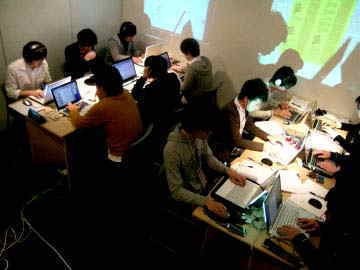
佐藤は、開場をするための受付スタッフなど、当日フリーペーパーを発行するため、裏を支えるスタッフを観察するために参加した。配置にあたり人選はどうしたのか、それは聞き漏らした。辻さんは文字起こしと編集の場に配属されていた。(下記グレーで囲った呟きを読むと辻さんは初参加だったことが分かる。右絵:文字起こしのようす)
当日配布されたフリーペーパーの表紙を右欄に貼っておく。内容はA4サイズ16頁とSNS投稿内容2頁だ。
合計18頁の編集には数多くの者を集める必要があった。主催者たちは、米国発で当時流行り始めたSNS(ソーシャル・ネットワーキング・サービス)を使っていた。若者たちもSNSを介し「チーム・LIVE RUNDABOUT JOURNAL」の活動を受け止め馳せ参じたのだろう。朝礼に参加した見当では、藤村龍至研究室の学生を含め50人弱が集まっていた。─ボランティア参加の女性は皆無だった、印象が残っていないだけか ─建築の言論の場も男たちの活動する領域だった─ 男子学生たちは関東圏に限らず(京都からも)建築とメディア発行に関心をもつ者が集まり、裏作業を支えた。(参考に当日参加した学生たちの声も少し拾い、記録にしたので興味の有る方は参照ください。)
地域の伝統的祭りに限らず、どのような種類の細やかなイベントだろうが、開催するためには裏仕事を協力してもらえる仲間を集め、持続する共感をつくり・共有する、その場をつくり始めることが肝要だ。けれど、2010年の参加者を結びとめ共感を生み出す場への思いはなんだったろうか・・それは「新しいメディアを創る場に参加し、建築知の歴史つくりに参加したい・・・」という建築的宗教観に似たような思いだったように感じた。中には有名人の実像を確かめるため参加していたかもしれない。参加者全て、ひとり、ひとりの思いを聞き取っていないので断言はできない。が、主催者のみならず参集した方々も、「あの場を支えた思いを言語化し継承する」その必要はあるだろう。このWEB頁は辻さんとの出会いを紹介するものだから、これ以上「LIVE RUNDABOUT JOURNAL」には深入りしない。
あの場所に居た辻さんは、後日下記のように語っている。
2010年2月20日 17:09 辻琢磨 (24才)さん より(辻さん ツイッタへ) 初めてのLRAJ(ライブ・ラウンド・アバウトジャーナル)でしたが藤村龍至さんはじめ、山崎泰寛さんや松島潤平さんに声をかけて頂き、彼らが作り出す程よい緊張感を体験出来たこと、嬉しく思っております。 初めてのLRAJ(ライブ・ラウンド・アバウトジャーナル)でしたが藤村龍至さんはじめ、山崎泰寛さんや松島潤平さんに声をかけて頂き、彼らが作り出す程よい緊張感を体験出来たこと、嬉しく思っております。
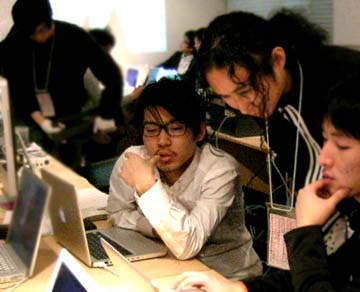 編集作業に関しては、昨年も同様の作業を経験しているg86の鎌谷潤くんがコツを的確に教えてくれたので、なんとかやり切ることが出来ました。1ターンの編集時間は30分。あれだけハイ・コンテクストな議論の核心を5分でつかみ、15分でバッサリ削り、5分でジリジリ削り、5分で調整といった具合ですが、実際は目の前の一行一行と格闘している感じで途中からほぼ思考が停止し(作業放棄ではありません)、半ば自動的に作業していたと思います。 編集作業に関しては、昨年も同様の作業を経験しているg86の鎌谷潤くんがコツを的確に教えてくれたので、なんとかやり切ることが出来ました。1ターンの編集時間は30分。あれだけハイ・コンテクストな議論の核心を5分でつかみ、15分でバッサリ削り、5分でジリジリ削り、5分で調整といった具合ですが、実際は目の前の一行一行と格闘している感じで途中からほぼ思考が停止し(作業放棄ではありません)、半ば自動的に作業していたと思います。(中央 辻さん) 結果的にその時の詳しい内容や思考は覚えていません。ですが、実物としてあのフリーペーパーは確かに存在した。そういう事実が一番大事だと思っています。 余談ですが、磯崎新氏の文章編集だけは異様に疲れました。彼の言葉のそれぞれはズルズルつながっていて、どこも削れない、要約出来ないという気にさせられて頭がおかしくなりそうでした。要約ってそもそも合理的な作業だから、彼の言葉自体が要約という合理作業に対して喧嘩を売っているような感じでした。それでもなんとか削ったわけで、不安でしたが、「ただプロセスだけが時代を超えていく」という素晴らしい見出しを見て、ほっとしました。 貴重な爽快感をくれたRAJのみなさま、関係者のみなさま、来場のみなさま、本当にありがとうございました。
|
主な様子を紹介するために作成した動画
2011年の会場など
2010年2月6日朝礼・記録より 抜粋
藤村:佐藤さん。我々はチームラウンドアバウトという活動やってますけど、(建築あそび)は言わばロールモデルです。・・・・・・今日は第一部と第二部があります。第一部は1時から、第二部が5時半から。・・・第一部は個別のセッションで、学会みたいな感じで1時間ごとに区切ってレクチャを2人ないしは3人ずつやっていきます。第二部はゆわゆるシンポジュームで、4人の人達が登壇をしてデスカッションをするという形式です。

絵:2010年2月6日(有)藤村龍至建築事務所発行『RUNDABOUT JOURNAL VOL10』
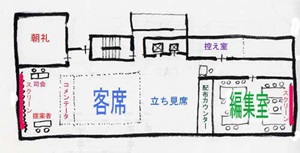
会場の全体図
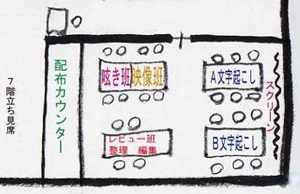
文字起こし、編集 呟き、映像班の配置
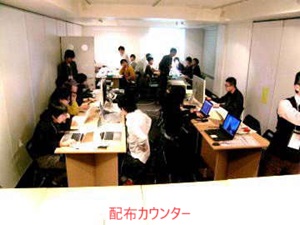
配布カウンター越しに奥の文字起こし隊を見る
01encounter
The first time I met Takuma Tsuji was on the 7th floor of an equipment manufacturer's building (INAX Ginza) in Ginza. The date and time was 9:20 a.m. on February 6, 2010.(Diary of the next day)
The third "LIVE RUNDABOUT JOURNAL" was held that day. The content of the event was to "talk about cities and architecture. Arata Isozaki, who passed away on December 8, 2022, was scheduled to appear as a guest.
In addition to the talk show, there was a bonus that day. It was a free paper distributed on the day. The free paper, "Rundabout Journal Vol. 10," was transcribed, edited, printed, and distributed on the same floor as the talks that took place in front of the audience. The audience lined up long after the talk show because they could receive and memorize the content of the voices of the participants.
People who picked up the free paper distributed at the event and were involved in architectural print media, which had almost disappeared after the web media took its place, said, "It's so violent to print and distribute the paper on the same day.... They were jealous of the free paper and said, "I want to imitate them too! I don't have the power and popularity to gather the manpower..." They must have thought, "I don't want to copy them either. At the same time, they must have confirmed the merits of the old print media. That's why they attracted public attention.
In 1995, personal computers with Microsoft processors were sold, which prompted innovation in the existing society. Therefore, university students learning to use PCs became common, and not only in the field of architecture. Fifteen years later, young architects in Ginza also took the PC as their weapon of choice, and volunteer staff in their 20s, with PCs under their arm, gathered to make changes on the day of the exhibition, edit, print, and distribute. The young PC users who gathered to participate in the project were the first to try their hand at it in Japan. I repeat, the editors who had traditionally used paper media for their publications might have been appalled at the idea of distributing paper media on the day of the event, and might have taken it as some kind of childish acrobatics. So it must have been an instantaneous topic of conversation. Students with unbalanced minds, who had learned by watching paper media as a matter of course, must have rushed to the event.
The venue was hot and tense, partly due to the low ceiling. The audience may have been looking only at the front of the stage. The volunteer staff, including Takuma Tsuji, took up positions in the back of the auditorium. There, they were repeatedly translating the guests' voices into words, as if they were discovering and discovering themselves. Sato saw more of the behind-the-scenes than the stars on stage. I remember that I was there when the PC revolutionized the architectural medium.
 Sato was there to observe the staff behind the scenes, including the reception
staff to open the doors and to publish the free paper on the day of the
event. He did not ask how the staff was selected for assignment. Mr. Tsuji
was assigned to the transcription and editing area. (If you read the mumblings
circled in gray below, you will see that Mr. Tsuji was a first-time participant.
(Picture on the right: Transcription)
Sato was there to observe the staff behind the scenes, including the reception
staff to open the doors and to publish the free paper on the day of the
event. He did not ask how the staff was selected for assignment. Mr. Tsuji
was assigned to the transcription and editing area. (If you read the mumblings
circled in gray below, you will see that Mr. Tsuji was a first-time participant.
(Picture on the right: Transcription)The cover of the free paper distributed on the day of the event is pasted in the right column. It is 16 pages of A4 size and 2 pages of SNS contributions.
It was necessary to gather numerous people to edit a total of 18 pages. The organizers used social networking services (SNS), which originated in the United States and were just becoming popular at the time. Young people must have also received the activities of "Team LIVE RUNDABOUT JOURNAL" through social networking services and came to the event. According to the estimates I received at the morning meeting, there were less than 50 people in attendance, including students from Ryuji Fujimura's laboratory. The male students, who were interested in architecture and media publishing, gathered not only from the Kanto area (but also from Kyoto) to support the behind-the-scenes work. (Comments from students who participated on the day for reference)
In order to hold any kind of small event, not limited to traditional local festivals, it is essential to gather people who can help with the behind-the-scenes work, create lasting empathy, and begin to create a place for sharing. But what was it that brought the participants together in 2010, and what was their desire for a place to create empathy? Some of the participants may have been there to see the real image of famous people. I cannot say for sure because I did not hear the thoughts of all the participants, one by one. However, it is necessary for not only the organizers but also the participants to "verbalize and pass on the thoughts and feelings that supported the event. This web page is an introduction to my encounter with Mr. Tsuji, so I will not go any deeper into the "LIVE RUNDABOUT JOURNAL".
Mr. Tsuji, who was present at that place, later said the following.
February 20, 2010 17:09 Takuma Tsuji (age 24)(辻さん ツイッタへ)  This was my first LRAJ (Live Round About Journal), and I was delighted
to be invited by Mr. Ryuji Fujimura, Mr. Yasuhiro Yamazaki, and Mr. Junpei
Matsushima, and to experience the moderate tension they created. This was my first LRAJ (Live Round About Journal), and I was delighted
to be invited by Mr. Ryuji Fujimura, Mr. Yasuhiro Yamazaki, and Mr. Junpei
Matsushima, and to experience the moderate tension they created.
As for the editing work, Jun Kamatani of g86,
 who had experienced similar work last year, gave us precise tips and tricks,
and we managed to get through it. who had experienced similar work last year, gave us precise tips and tricks,
and we managed to get through it.Each turn is 30 minutes of editing time. In reality, however, I felt like I was struggling with each line in front of me, and my thinking almost stopped halfway through (this is not an abandonment of work), and I think I was working semi-automatically. (Center Mr. Tsuji) As a result, I do not remember the detailed contents or thoughts at that time. However, I am sure that the free paper existed as a real thing. I think that fact is the most important. As an aside, I was unusually tired only of editing Arata Isozaki's text.Each
of his words was connected to the next, and I felt as if I was going crazy
because I felt as if I could not cut or summarize any part of his words.
I felt like I was losing my mind, because summarizing is a rational process,
and his words themselves seemed to be fighting against the rational process
of summarizing. Still, we managed to cut it down, and I was anxious, but
I was relieved to see the wonderful headline, "Only Process is Timeless. I
would like to thank everyone at RAJ, everyone involved, and everyone who
came to the exhibition for this precious and exhilarating experience.
|


左:2007年3月16日刊行、ラウンド・アバウト・ジャーナル1,2合併号など、紙媒体の数々。 右: 2010年2月6日 キオスクで買った朝刊。
INAX銀座7階に参集した若い方々(藤村ゼミ生を除く)の思いを的確に語れない。同様に辻さんのこともだ。辻琢磨さんは席を置いた横浜国立大学を出て「建築の何を探していたのか」聞いていない。参集した方々の当時の「夢や希望」のようなものを理解するには長い観察は要る。
眼の前にある学業の魅力を感じず、あるいは貪欲に、または余裕で参加したのだろうか、評価無しの自主イベントの何に魅力を感じ参加していたのだろうか。眼の前の若者たちは建築界にあっては極めて稀な「熱い自主性」を備えた人たちだと思った。ではINAX銀座7階に参加しなかった建築系学生たちは何を思っていたのだろうか。
■2010年 学生が目指した領域
それを知るため建築学会から2011年に報告された、「建築系大学生の進路に関する第五回調査報告書」を参照しよう。そこには総合建設業21%、ハウスメーカー13%、設計事務所10%、専門工事業7%、不動産業6%、官公庁・公団5%、研究・教育機関は1%などとある。2024年現在、彼らは社会の中堅となり、一級建築士免許証を受取、日本各地で活躍しているはずだ。
知人の県庁職員OBの話だと、「死亡しても免許を返納しない幽霊一級建築士が多数」なんだそうだ。2021年国交省によると下の表のように一級建築士は14万人弱だ。表はライブ・ランウンド・アバウト・ジャーナルから10年経った数値だ。辻琢磨さんを含む30代の一級建築士が1・4万人で全数の10%だ。

2024年、各業界の人手不足は本番に入ったようでニュースになったりする。一級建築士も早晩、極度の人手不足になり、多様な状況と要求に応じられる者は引く手あまたとなる。
では、2010年銀座に参集したいわゆる意識の高い人達の割合を見てみよう。一級建築士の中で「意識高い、我こそ建築家」と思い込む人々はどのぐらいの数、いるんだろう。JIA会員数を参照してみよう。国内に4700名のようで、彼らは一級建築士全体の3.3%だと分かる。
この数値は全国平均だから、佐藤が暮らす福島市や辻さんが生業を起動させた浜松市のような地方都市に、意識の高い一級建築士がどれだけ暮らしているのか、佐藤は建築系団体に所属していないので、分からない。
建築士数も東京や大阪、京都などの大都市に偏在しているので、大都市には我建築家なりと胸を張ってる者は5%ぐらいだとしておこう。ここからは邪推なのだが、意識は高いが仕事にありつけない者は、卒業した大学などの非常勤講師になったりして、高いプライドを守り、何もしらない学生たちに害を振りまいているのかもしれない。(佐藤は各地で聞き取っているので、害虫のような意識高い人は駆逐されたとも聞く。が、実態をしらない)
■建築業界が置かれた現況もざっと見ておこう
辻さん入門と題しているので、辻さんが置かれる建築業界の現況にも目を通しておこう。そこは、生業が消え、コミュニティが蒸発した大地だ。建築に置き換えれば災害対応に機敏に対応した工務店などが消えるなか、造りすぎた住宅が900万個も空き家になっている大地だ。建築荒れ地のような場所である。だから耕しかた次第では豊かな実りをもたらす耕作放棄地と、言い換えることができる。
建築的荒れ地の始まりは空襲された焼け野原だった。
1945年の敗戦によって軍人・民間人、660万人が引揚者に姿を変え、大陸などから押し寄せた。彼らには耕す土地も、住む家もない。食う物だって満足にない。日米戦末期に米軍は各地の都市に空襲し焼け野原にしてしまった。主要都市にだって家も無い、食い物を運ぶインフラもない。焼け出された人だらけだった。同時に親を失った戦災孤児もたくさん路上に暮らしていた。現在東京上野に行って地下道を歩くと、孤児たちのうめき声が聞こえる気がするが、表面を綺麗にしてしまったので戦後の表層は消されたが、構造はまま残っている。
なにもない大地に立つと人は頑張るようだ。焼け出された市民と行政は一致団結し、荒れ地を田畑に開墾し住宅も多数造り続けてきた。冬場に換金食物が作れない人たちは、季節労働者となり都会に出稼ぎにでて、巨大インフラやビルや住宅などを造り続け、家族を養い子供も育てた。
あれから75年の時は流れた。福島県では公営住宅を新築することをやめ、福島県住宅供給公社は2009年に解散した。高度成長期といわれた世で「国策としての持ち家」を推し進めた結果、あの持ち家は2024年現在900万戸の空き家となった。数合わせだけに奔走し本質的な(ポスト近代の)生活を想い描けなかった。それが誰にでも分かるようにシャッターに表層を覆い現れでた。居住政策も産業もポスト近代への移行を怠ったので、空き家問題となった。加えて産業移行を怠ったことで、シャッター通りや耕作放棄地から追い出された若い人は、派遣労働者数の増加となり、ある者は「秋葉原通り魔事件」(2008年)の主犯・ダーティーヒーローに姿を変えた。彼らは現在も津々浦々に、じっとストレスを蓄え、発散する場を待ち構えているのかもしれない。
■辻さんの家と村上亜沙美さんの職場
辻さんが暮らしている家は、お爺さんが昭和に建てた、浜松市郊外の宅地にある戸建て住宅だ。詳しくは「06これまでの作品を観て」に記する。郊外住宅問題と同様に「シャッター通り」と言われ各地に在る、空き店舗問題については「04村上亜紗美さんについて」で語ることにする。
「建築は極度に他者に依存して成る」事態なので、辻琢磨さんの内部に、他者を寛容し連携する能力の有無が問われる。それが21世紀の建築士の主なる姿なのだと思う。説明不足なので書き続けることで伝えることが叶えば幸いということにし「辻琢磨入門 01出会い」を〆ておこう。
2000年代についてキーワード例

『現代建築宣言文集 1960─2020』より
2000年代
アクティビティと空間 小嶋一浩
粒子へ砕く事 隈研吾
「原っぱ」と「遊園地」青木淳
パラドックスからカラオオケへ 隈研吾
建築の4層構造 難波和彦
原始的な未来の建築 藤本壮介
グーグル的建築家像をめざして 藤村龍至

『現代建築─社会を映し出す建築の100年史』
2000年代 グローバル化する都市CCTV的なるものより
アメリカ同時多発テロ
せんだいメディアテーク
サードプレイス
ソーシャルキャピタル
都市再生特別措置法
お台場
タワーマンション
ショッピングセンター
リノベーション
大改造!!劇的ビフォー・アフター
限界集落
地域アート
金沢21世紀美術館
アルゴリズミック・デザイン
耐震改修
耐震計算書偽造問題
東京駅復元
中国中央電視台
ウィキペディア
ザ・タワー
I cannot accurately describe the thoughts of the young people (excluding Fujimura seminar students) who gathered on the 7th floor of INAX Ginza. The same goes for Mr. Tsuji. Takuma Tsuji left Yokohama National University, where he had been sitting, and I did not ask him "what he was looking for in architecture. A long observation is necessary to understand the "dreams and hopes" of the participants at that time.
I wondered if they were not attracted by the academic work in front of them, or if they participated greedily or in good time, or what they found attractive about the independent event without evaluation. I thought the young people in front of me were people with "passionate independence," which is extremely rare in the architectural world. Then, what were the architecture students who did not participate in the INAX Ginza 7th floor thinking?
■2010 Areas of study aimed at by students
To find out, let us refer to the "Fifth Survey Report on the Career Paths of Architecture Students" reported by the Architectural Institute of Japan in 2011.
There, the general construction industry 21%,Housebuilders 13%,Design firm 10%,Specialty trade 7%,Real estate 6%、Public offices and public corporations 5%、Educational institutions are 1%, etc., As of 2024, they should be middle-class members of society, receiving first-class architect licenses and active in various parts of Japan.
According to an acquaintance of mine who is an alumnus of the prefectural government, there are "many ghost first-class architects who do not return their licenses after death.The table shows the figures 10 years after Live Run Around About Journal. There are 14,000 first-class architects in their 30s, including Takuma Tsuji, 10% of the total number.

In 2024, the labor shortage in various industries seems to be in full swing and is making news. First-class architects will soon be in extremely short supply, and those who can respond to a wide variety of situations and demands will be in great demand.
Let's take a look at the percentage of so-called "conscious people" who gathered in Ginza in 2010. Let's look at the number of first-class architects who consider themselves to be "highly conscious architects. Let's look at the number of JIA members, and we find that there are 4,700 members in Japan, which is 3.3% of the total number of first-class architects.
These figures are a national average, so Sato does not know how many conscious first-class architects live in regional cities like Fukushima City, where he lives, or Hamamatsu City, where Mr. Tsuji has launched his business, because he does not belong to any architectural organizations.
The number of architects is also unevenly distributed in big cities such as Tokyo, Osaka, and Kyoto, so let's say that only about 5% of architects in big cities are proud to call themselves architects. This is a bad guess, but those who are highly conscious but unable to find work may become part-time lecturers at the universities from which they graduated, protecting their high pride and causing harm to students who have no idea what they are talking about.((Sato has heard from many places, and he also hears that conscious people like pests have been exterminated. (Sato has heard from many places, so he does not know the actual situation.)
■Let's also take a quick look at the current state of the building industry.
Since this is titled "Introduction to Mr. Tsuji," let us take a look at the current state of the construction industry in which Mr. Tsuji finds himself. It is a land where livelihoods have disappeared and communities have evaporated. In terms of architecture, it is a land where construction firms that responded quickly to disasters have disappeared, and where 9 million overbuilt houses lie vacant. It is like a construction wasteland. It is, therefore, a kind of abandoned farmland that can yield abundant harvests, depending on how it is cultivated.
The architectural wasteland began as a burnt-out area that was bombed out.
With the defeat of Japan in 1945, 6.6 million people, both military and civilian, were transformed into repatriates, pouring in from the continent and elsewhere. They had no land to cultivate and no homes to live in. They had no land to cultivate, no houses to live in, and not enough food to eat. At the end of the war between the U.S. and Japan, the U.S. military bombed and burned many cities to the ground. Even major cities had no houses and no infrastructure to transport food. The cities were full of people who had been burned out. At the same time, many war orphans who had lost their parents were living on the streets. Today, if you go to Ueno in Tokyo and walk through the underpass, you can hear the groans of the orphans, but the surface has been cleaned up so that the postwar surface has been erased, but the structure remains.
It seems that people will do their best when they stand on an empty land. Citizens and the government united to cultivate the wasteland into fields and build many houses. Those who were unable to produce cash crops in the winter became seasonal laborers and went to work in the cities, where they continued to build huge infrastructure, buildings, and houses to support their families and raise their children.
Seventy-five years have passed since then. Fukushima Prefecture stopped building new public housing, and the Fukushima Prefectural Housing Supply Corporation was dissolved in 2009. As a result of promoting "owner-occupied houses as a national policy" during the era of rapid economic growth, there are 9 million vacant owner-occupied houses as of 2024. The government was only concerned with the numbers, and failed to envision the essential (post-modern) lifestyle. The shutters covered the surface of the houses so that everyone could see them. The problem of vacant houses became a problem because both residential policy and industry failed to make the transition to the post-modern era. In addition, the young people who were forced out of the shuttered streets and abandoned farmland by the lack of industrial transition became an increasing number of temporary workers, some of whom turned into dirty heroes, the main perpetrators of the "Akihabara street riot" (2008). They may still be waiting for a place to store up and release their stress in various parts of Japan.
■Ms. Tsuji's house and Asami Murakami's workplace
The house where Mr. Tsuji lives is a detached house on a lot in the suburbs of Hamamatsu City, built by his grandfather in the Showa period. For details, please refer to "06: Viewing the Past Works". The problem of vacant storefronts, known as "shutter streets," which are found in many places, as well as the problem of suburban housing, will be discussed in "04 About Asami Murakami.
Since "architecture is extremely dependent on others," Takuma Tsuji's ability to tolerate and collaborate with others must be questioned. I believe that this is the main form of an architect in the 21st century. I will close "Introduction to Takuma Tsuji: Encounter 01" with the hope that I have conveyed this message through my continued writing.
(付記)
■RAJについては別のタイトルで語ることがあるかもしれないのでメモだけ残す。
佐藤は福島市にあった旅館竹屋で、主催者であり主メンバーの現在建築事務所主催・藤井亮介さん、組織事務所に勤務する伊庭野大輔さん、北海道大学で教員を勤める松島潤平さん、東京芸術大学で教員を勤める藤村龍至さんと、25時間ほど喋り通した。その記録を作り公開しているので興味のある方は「建築あそびin竹屋」を開き参照ください。
RAJの主メンバは帰宅の電車の中で出会い、語り合うようになったそうだ。東工大での自主的な活動名は、「全力ゼミ」。その発展形式としての「RAJ」だ。それぞれの動機も語られている。また、当日のタイム・スケジュールについては伊庭野さんが詳しく語っている。
ではなぜ、彼らの活動が起きたのか?その背景を簡単に見ておきたい、ライブ・ラウンド・アバウトジャーナルとは何なんだったのか、いかに生まれ消えたのか、それらの背景などを含め、2010年 東日本大震災発生前年の建築的活気についても、別タイトルで書くか、語り合い記録を残すことにしてみたい。
建築系紙媒体はスーパーゼネコンや設備機器メーカーに依存してなっていたとは言える。RAJの資金支援をしたのもそれらだ。同人誌的紙媒体もすこし知っているが、2024年現在は個々人がwebやSNSを活用している。で今は皆無だと思う。07 「更新設計」が生まれる背景で深堀りしてみたい。(註:書き残さないかもしれない)
(addendum)
■ will just leave a note about RAJ as I may have something to say about it under another title.
Sato spent about 25 hours talking at the Ryokan Takeya in Fukushima City with the organizer and main member, Ryosuke Fujii, currently an architectural office manager, Daisuke Ibano, who works at an organizational office, Junpei Matsushima, a faculty member at Hokkaido University, and Ryuji Fujimura, a faculty member at Tokyo University of the Arts.The record of the event is available to the public, so if you are interested, please refer to the "Architectural Asobi建築あそびin竹屋 in Takeya" page.
The main members of RAJ met on the train going home and started talking to each other. The name of their voluntary activity at Tokyo Tech was "Zenryoku Seminar. RAJ" is a developmental form of that. The motivations behind each of these activities are also discussed. Mr. Ibano also details the time schedule of the day's events.
So why did their activities occur? I would like to take a brief look at the background, what was Live Round About Journal, how it was born and disappeared, including those backgrounds, and I would like to write or discuss and record the architectural liveliness in the year before the Great East Japan Earthquake occurred in 2010 under a different title.
It can be said that the building-related print media has become dependent on super general contractors and equipment manufacturers, who provided the financial support for RAJ. I know of a few fanzine-like print media, but in 2024, individuals are using the web and social networking services, and I don't think there are any now. 07 I would like to dig deeper in the background of the creation of the "updated design".(Note: may not be left out)